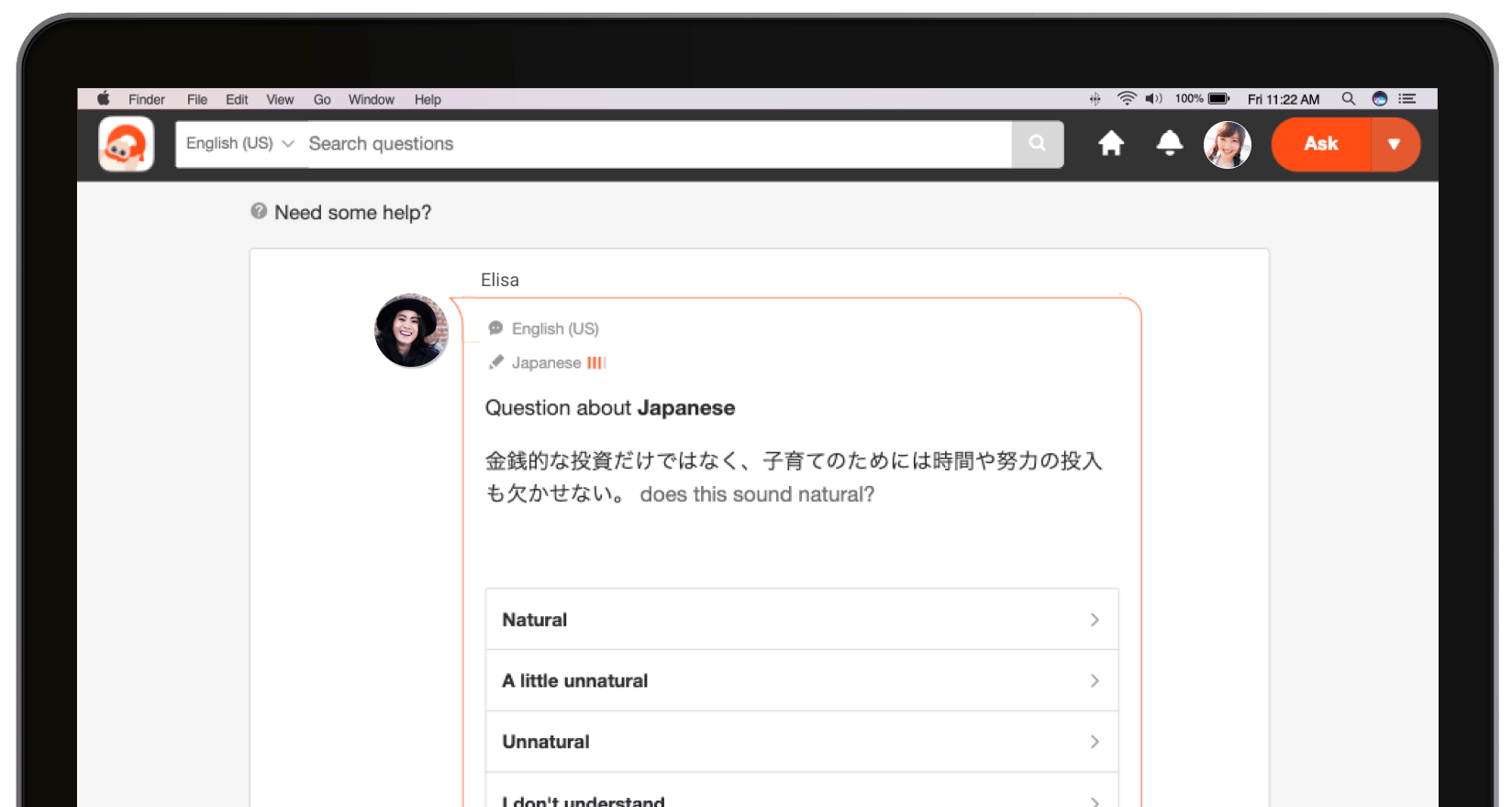質問
最終更新日:
2022年1月26日
- ドイツ語
-
日本語
-
英語 (アメリカ)
日本語 に関する質問
When do you use onyomi and when you use kunyoumi readings at kanjis?
Can you give me examples with the kanji 水?
When do you use onyomi and when you use kunyoumi readings at kanjis?
Can you give me examples with the kanji 水?
Can you give me examples with the kanji 水?
回答
過去のコメントを読み込む
- 日本語
水筒(すいとう/おんよみ)に水(みず/くんよみ)を入れて持って行きます。
suitou ni mizu o irete motte ikimasu.
評価の高い回答者
この回答は役に立ちましたか?
- 日本語
Which reading to use is determined on a word-by-word.
For example the reading of 真水 is always mamizu (kun-yomi) and the reading of 水筒 is always suitou (on-yomi). Some words have both ways, like the reading of 水面 is sometimes suimen (on) and sometimes minamo (kun).
Vocabularies are important to distinguish which way to read. For example, if you see the kanji 水筒 and don't know whether to read it as "suitou" or "mizutsutsu," it simply means that you don't know that the word "suitou" exists and the word "mizutsutsu" does not.
評価の高い回答者
この回答は役に立ちましたか?
- 日本語
We usually read kanji in context.
When it is used in form of 水道, we read it suido.
And when it is used in 水を飲む, we read it mizu.
We may use onyomi, when it is used in combination of kanji.But it is not always. It is difficult problem.
この回答は役に立ちましたか?
- 日本語
Kunyomi is the Japanese reading of the word, while onyomi is the Chinese-derived reading. The word "mizu", which means "water", originally existed in Japanese, and the kanji "水" (read as "sui" in Chinese at the time), which means "water", was later introduced from China. In other words, kunyomi is the reading of the kanji as it is in the Japanese language. On the other hand, onyomi is a reading of the kanji by itself, and the sound itself does not have any meaning in Japanese, but can only be formed as a word when combined with other kanji (e.g. 水道/suidō, 水滴/suiteki, 水蒸気/suijyōki 水車/suisha).
To put it simply, kunyomi has a meaning in its sound, and if you say "mizu", people will understand that it means "water", while onyomi is a reading of the kanji itself, with no meaning in its sound, and if you say "sui" by itself, people will not understand.
When reading a sentence, if 水 seems to form a word by itself, it may be read as "mizu", and if it is part of a word, it may be read as "sui" (or sometimes "zui", depending on word order).
評価の高い回答者
この回答は役に立ちましたか?
- 日本語
It depends on the word, so you can't say there's a pattern unconditionally.
Basically however, you can read two or more consecutive kanjis as onyomi.
Ex.
水面 すいめん(onyomi)
写真 しゃしん(onyomi)
会議 かいぎ(onyomi)
One kanji can be often read as kunyomi to the contrary.
Ex.
水 みず(kunyomi)
机 つくえ(kunyomi)
雲 くも(kunyomi)
Of course, there are exceptions.
Ex.
相方 あいかた(kunyomi)
本 ほん(onyomi)
Ex.
水 みず(kunyomi)
水道 すいどう(onyomi)
温水 おんすい(onyomi)
海水 かいすい(onyomi)
雨水 あまみず(kunyomi)
水道の水を飲みました。
この川の水は綺麗です。
この回答は役に立ちましたか?
- 日本語
@Kul_Raik
Die ”on-yomi” eines Zeichens ist immer drei oder weniger Zeichen lang, wenn es in Kana geschrieben wird. Dies ist ein Überbleibsel der Tatsache, dass im Chinesischen jedes chinesische Zeichen immer mit einer Silbe ausgesprochen wird. Daher ist jede Lesung, die aus vier oder mehr Zeichen besteht, wie zum Beispiel "比” gelesen als "くらべる” oder "慌” gelesen als "あわただしい”, eine kun-yomi.
Auch bei den 3-Zeichen-Lesungen gibt es ein gemeinsames Merkmal im on-yomi. Das zweite Zeichen ist immer ein kleines "ゃ", "ゅ" oder "ょ". Wenn Sie also "思" als "おもう" und "遊" als "あそぶ" lesen, dann lesen Sie eindeutig kun-yomi. Liest man dagegen zum Beispiel "流" für "りゅう" oder "小" für "しょう", kann man sicher sein, dass es sich um eine on-yomi-Lesung handelt.
Auch bei den zweistelligen Lesungen gibt es ein gemeinsames Merkmal des on-yomi. Das zweite Zeichen ist immer eines der folgenden: "い", "う", "つ", "く", "ち", "き" oder "ん". Wenn Sie also "家" für "いえ" und "浜" für "はま" lesen, dann lesen Sie kun-yomi.
Das Problem ist jedoch, dass einige Lesungen, die mit dem zweiten Zeichen "い", "う", "つ", "く", "ち", "き" oder "ん" enden, ebenfalls kun-yomi sind. Zum Beispiel wird "靴" als "くつ" gelesen, was auf "つ" endet, aber ein kun-yomi ist. Wenn man ein weiteres Zeichen hinzufügt, erhält man ein Wort, bei dem schwer zu entscheiden ist, ob es sich um ein on-yomi oder ein kun-yomi handelt.
Letztendlich kann man das nur herausfinden, indem man sie einzeln in einem Wörterbuch nachschlägt. Leider scheint es keine absolute Möglichkeit zu geben, zwischen on-yomi und kun-yomi zu unterscheiden.
評価の高い回答者
この回答は役に立ちましたか?
- 日本語
@Kul_Raik
Auch "濁音(がぎぐげごusw.) oder einem ら-Strich (らりるれろ) beginnt, ist on-yomi".
評価の高い回答者
この回答は役に立ちましたか?
[お知らせ]語学を学習中のあなたへ
語学を上達させる方法を知っていますか❓それは、自分で書いた文章をネイティブスピーカーに添削してもらうことです!
HiNativeなら、無料でネイティブスピーカーがあなたの文章を添削してくれます✍️✨
HiNativeなら、無料でネイティブスピーカーがあなたの文章を添削してくれます✍️✨
新規登録
話題の質問
- Could you please show me how you use the expression どうにでもなれ, maybe in a short dialogue or something?
- 二つの言い方は 完全に同じ意味ですか?教えてください! おかしい人だ。 変わった人だ。
- Could you please show me how you use どうにでも?
- 「佐々木さんは日本語が全然ダメそうです。」これは正しい日本語でしょうか。
- 駅であいましょうと駅にあいましょうはどう違いますか?
新着質問(HOT)
- 毎日一時間以上ピアノの練習をするように( )。 Aします Bなります Cあります Dいます
- ゴミ箱の底にはカビのはえたみかんの皮がへばりついているし、灰皿がわりの缶詰には吸殻が十センチもつもっていて、それがくすぶるとコーヒーかビールかそんなものをかけて消すものだから、むっとするすえた匂...
- 日本は雨の多い国である。さっきまでいい天気だったのに、突然、空が真っ暗になることは珍しくない。 雨の日の電車5に乗ると、 「本日はカかさの忘れ物が多くなっております。かさを忘れないようご注意願い...
- 中田さんが大学を卒業できた( )知っていますか? Aだろうか Bかどうか Cように Dために
- 「大雨のために、飛行機は十二時間にわたって遅れた。」という表現が正しいですか。 教えてください。
新着質問
- どんな 修学旅行に いきたいですか? 海外修学旅行に行きたいです。 Does this sound natural? ありがとうございます!
- Can I say this quote 私たちは大きな声で歌いました。also in this way —-> 私たちは大いに歌いました
- ありがた味はどういう意味ですか
- YouTubeでオリーブオイル顔と言う表現を学びました。 そしてこの表現は日本人には絶対分かるから日本人に対して使っては行けないと聞きました。 その理由は何ですか? ネットで探したら俳優の...
- しがみつくはどういう意味ですか
前後の質問

ありがとうございます!フィードバックは回答者には伝わりません。ご安心ください。
 ありがとうございます!サービスの体験向上の参考にさせていただきます。
ありがとうございます!サービスの体験向上の参考にさせていただきます。












